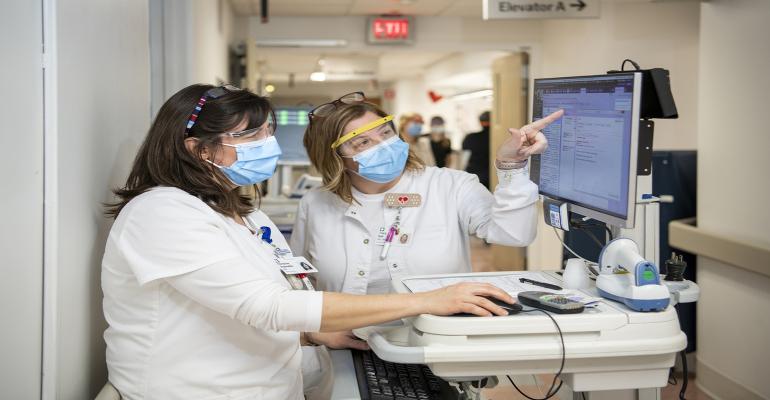In the wake of the COVID-19 pandemic, Cleveland Clinic began using telemedicine and virtual health strategies to provide care for patients – especially in primary care and home care settings. In the span of just five weeks, Cleveland Clinic outpatient visits increased from 2% remote (virtual or phone) to 75% remote.
“In the early stages of this pandemic, we did not know a lot about how the virus behaved and affected people. So out of an abundance of caution, any visit that could be done virtually was done virtually,” says Kristine Adams, MSN, CNP, Associate Chief Nursing Officer of Care Management and Ambulatory Services. “Telemedicine was critical in this stage to keep our patients safe yet engaged in their ongoing care, preventing worsening of the disease and potential infection with the virus.”
To quickly and effectively ramp up telehealth services, several steps were taken almost simultaneously. Cleveland Clinic expanded telehealth privileges, trained and reorganized its workforce (including nurses), and created new documentation and workflows. “Our ambulatory care management nurses pivoted quickly to a virtual and telephonic platform to manage our highest risk chronic disease patients, as well as our COVID-positive patients who were not in hospital but being monitored for signs and symptoms at home,” says Adams.
Home monitoring of COVID-19 patients
Using a unique technology available through Epic’s MyChart, Cleveland Clinic was the first healthcare system to customize MyChart Care Companion to enhance the Home Monitoring Program for patients who test positive for COVID-19 at a Cleveland Clinic facility or is suspected of having it. Patients must agree to be enrolled in the easy-to-use program, which is available through their MyChart account on a mobile app or website.
“Once the COVID-19 test comes back positive, we reach out to the patient to learn more about their symptoms, provide education, offer support and help them sign up for the MyChart Care Companion platform,” says Michelle Card, MSN, RN BC, CCTM, Manager for Primary Care Coordination, who led the Home Monitoring Program team.
For 14 days, patients receive a daily questionnaire about their symptoms, and if they are better, the same as or worse than yesterday. Any worsening symptom response triggers a real-time message to a pool of registered nurses, prompting a phone call to the patient to further assess and determine next steps, such as additional care at home, a virtual visit with a provider or getting to an emergency department if necessary.
“A diagnosis of COVID-19 causes a lot of stress and anxiety for patients,” says Card. “Our regular contact helps to alleviate some of that anxiety by providing ongoing support, human contact during a time of isolation and reassurance to the patient that we are watching for those MyChart Care Companion responses.”
Ultimately, the program is intended to address emergent symptoms sooner, preventing hospital admissions and an inpatient surge. But it’s also designed to increase patient engagement.

Managing patients with chronic conditions
Soon into the pandemic, it became clear that patients with chronic diseases were not visiting their physicians. Cleveland Clinic began using the MyChart Care Companion platform to monitor these patients at home. To ensure that the health of patients with chronic conditions was being managed, nurses and care coordinators also called patients weekly to see if patients had any new or worsening symptoms they would like to discuss with their physician. If they did, then the caregiver found out more information and took action accordingly based on patients’ responses.
“Our priorities are to keep our patients with chronic conditions well at home, ensure they have the medications they need, provide education on how to remain safe and reduce their chance of contracting COVID-19, support the stability of their chronic disease and provide for any psychosocial needs,” says Card.
“During this pandemic, it is critical that we don’t minimize the importance of supporting our patients with chronic conditions,” she says. “Collaborating with many healthcare providers and leveraging technology allowed nurses to reach more patients, address changes in their health and connect them virtually to the right providers.”
This article appears in the latest issue of Omnia Health Magazine. Read the full issue online today, covering femtech, AI, IoT and much more.


